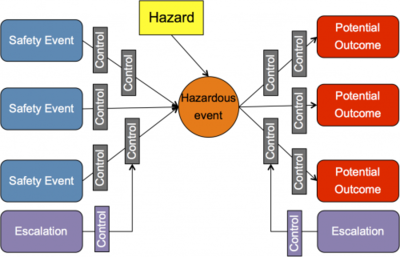Difference between revisions of "The Bowtie Method"
(Created page with "'''The Bowtie Method''' is a risk evaluation method that can be used to analyse and demonstrate causal relationships in high risk scenarios. The method takes its name from the...") |
|||
| Line 5: | Line 5: | ||
Besides the basic Bowtie diagram, management systems should also be considered and integrated with the Bowtie to give an overview of what activities keep a Control working and who is responsible for a Control. Integrating the management system in a Bowtie demonstrates how Hazards are managed by a company. The Bowtie can also be used effectively to assure that Hazards are managed to an acceptable level (ALARP). By combining the strengths of several safety techniques and the contribution of human and organisational factors, Bowtie diagrams facilitate workforce understanding of Hazard management and their own role in it. It is a method that can be understood by all layers of the organisation due to its highly visual and intuitive nature, while it also provides new insights to the HSE professional.<ref>Definition - What is The Bowtie Method [https://www.cgerisk.com/knowledgebase/The_history_of_bowtie CGE Risk]</ref> | Besides the basic Bowtie diagram, management systems should also be considered and integrated with the Bowtie to give an overview of what activities keep a Control working and who is responsible for a Control. Integrating the management system in a Bowtie demonstrates how Hazards are managed by a company. The Bowtie can also be used effectively to assure that Hazards are managed to an acceptable level (ALARP). By combining the strengths of several safety techniques and the contribution of human and organisational factors, Bowtie diagrams facilitate workforce understanding of Hazard management and their own role in it. It is a method that can be understood by all layers of the organisation due to its highly visual and intuitive nature, while it also provides new insights to the HSE professional.<ref>Definition - What is The Bowtie Method [https://www.cgerisk.com/knowledgebase/The_history_of_bowtie CGE Risk]</ref> | ||
| + | |||
| + | |||
| + | Construction of a Bow Tie diagram involves asking a structured set of questions:<ref>Construction of a Bow Tie diagram [[https://www.skybrary.aero/index.php/Bow_Tie_Risk_Management_Methodology Skybrary]</ref> | ||
| + | *What is the hazard? | ||
| + | *What happens when hazard control is lost? | ||
| + | *What safety event (threat) could release the hazard? | ||
| + | *What are the potential outcomes? | ||
| + | *How can we avoid the undesired/hazardous event? | ||
| + | *How can we recover if the event occurs? How can the potential outcome likelihood or consequence severity be limited? | ||
| + | *How might controls fail? How could their effectiveness become undermined? | ||
| + | *How do we make sure that controls do not fail? | ||
| + | |||
| + | |||
| + | [[File:Bowtie_Diagram.png|400px|Bowtie Diagram]]<br /> | ||
| + | source: [https://www.skybrary.aero/index.php/Bow_Tie_Risk_Management_Methodology Skybrary] | ||
Revision as of 19:47, 19 March 2020
The Bowtie Method is a risk evaluation method that can be used to analyse and demonstrate causal relationships in high risk scenarios. The method takes its name from the shape of the diagram that you create, which looks like a men’s bowtie. A Bowtie diagram does two things.
- First of all, a Bowtie gives a visual summary of all plausible accident scenarios that could exist around a certain Hazard.
- Second, by identifying control measures the Bowtie displays what a company does to control those scenarios.
Once the control measures are identified, the Bowtie method takes it one step further and identifies the ways in which control measures fail. These factors or conditions are called Escalation factors. There are possible control measures for Escalation factors as well, which is why there is also a special type of control called an Escalation factor control, which has an indirect but crucial effect on the main Hazard. By visualising the interaction between Controls and their Escalation factors one can see how the overall system weakens when Controls have Escalation factors.
Besides the basic Bowtie diagram, management systems should also be considered and integrated with the Bowtie to give an overview of what activities keep a Control working and who is responsible for a Control. Integrating the management system in a Bowtie demonstrates how Hazards are managed by a company. The Bowtie can also be used effectively to assure that Hazards are managed to an acceptable level (ALARP). By combining the strengths of several safety techniques and the contribution of human and organisational factors, Bowtie diagrams facilitate workforce understanding of Hazard management and their own role in it. It is a method that can be understood by all layers of the organisation due to its highly visual and intuitive nature, while it also provides new insights to the HSE professional.[1]
Construction of a Bow Tie diagram involves asking a structured set of questions:[2]
- What is the hazard?
- What happens when hazard control is lost?
- What safety event (threat) could release the hazard?
- What are the potential outcomes?
- How can we avoid the undesired/hazardous event?
- How can we recover if the event occurs? How can the potential outcome likelihood or consequence severity be limited?
- How might controls fail? How could their effectiveness become undermined?
- How do we make sure that controls do not fail?

source: Skybrary
